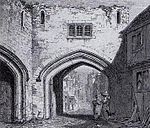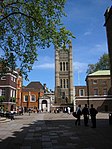Church House, Westminster
Denomination headquarters in the United KingdomGrade II listed buildings in the City of Westminster

The Church House is the home of the headquarters of the Church of England, occupying the south end of Dean's Yard next to Westminster Abbey in London. Besides providing administrative offices for the Church Commissioners, the Archbishops' Council and the Church of England Pensions Board, and a chamber for the General Synod, the building also provided a meeting place for the Parliament of the United Kingdom during World War II, and for some of the organs of the newly formed United Nations afterwards, including the first meeting of the UN Security Council. It has more recently been the venue for several notable public enquiries.
Excerpt from the Wikipedia article Church House, Westminster (License: CC BY-SA 3.0, Authors, Images).Church House, Westminster
Great Smith Street, London Millbank
Geographical coordinates (GPS) Address External links Nearby Places Show on map
Geographical coordinates (GPS)
| Latitude | Longitude |
|---|---|
| N 51.497777777778 ° | E -0.12944444444444 ° |
Address
Church House
Great Smith Street
SW1P 3BL London, Millbank
England, United Kingdom
Open on Google Maps






